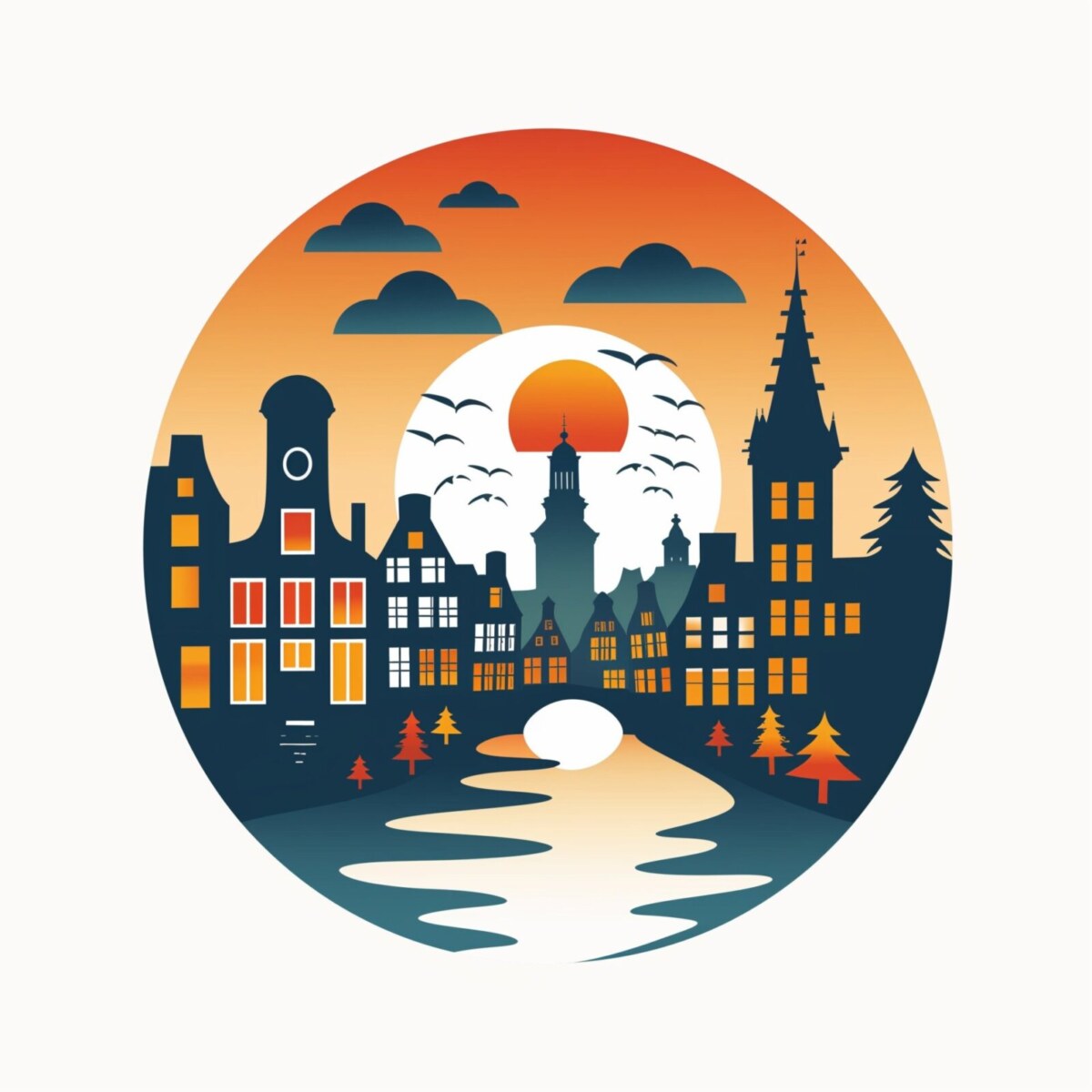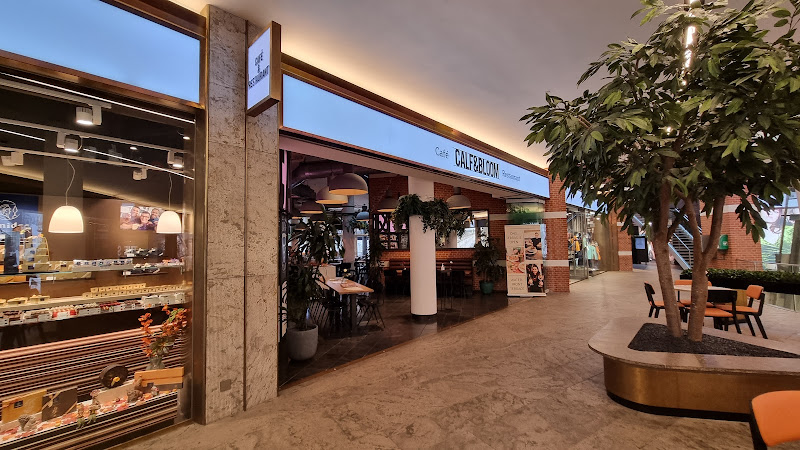The Kalverpassage stands as both a contemporary shopping arcade and a vital pedestrian artery connecting some of the city’s most iconic streets. This sleek, light-filled passage offers a perfect blend of retail therapy, culinary delights, mesmerizing art installations, and a touch of Amsterdam’s rich history. Far more than just a shopping center, the Kalverpassage represents a thoughtful example of urban design that harmoniously weaves modern architecture into Amsterdam’s historic fabric.
Located between Kalverstraat (Amsterdam’s busiest shopping street), Heiligeweg, and the picturesque Singel canal, this innovative space invites visitors to explore a carefully curated collection of shops and restaurants while experiencing stunning contemporary art and a beautifully preserved 17th-century gate—all under one spectacular LED ceiling.
A Journey Through Time: From Kalvertoren to Kalverpassage
The site now occupied by Kalverpassage was previously home to the Kalvertoren (Calf Tower) shopping center. Opened around 1997, the Kalvertoren quickly gained recognition for its distinctive glass and steel tower that offered panoramic views of Amsterdam from its top-floor restaurant.
A significant transformation began in 2016 when the Kroonenberg Groep acquired the property and embarked on an ambitious renovation project. Their vision went beyond just another shopping destination—they aimed to establish a dynamic “shopping arcade” that would serve as an “appealing connection” between the surrounding streets.
The renovation was completed in April 2018, unveiling the renamed “Kalverpassage.” This name change from “Kalvertoren” (Calf Tower) to “Kalverpassage” (Calf Passage) symbolizes the fundamental shift in concept, from vertical focus to horizontal flow and connectivity.
The Historical Treasure Within
One of the most remarkable aspects of the Kalverpassage is the sensitive incorporation of the 17th-century Rasphuispoort (Grating House Gate). Dating from approximately 1603, this ornate gate was designed by celebrated Amsterdam City Architect Hendrick de Keyser.
Originally serving as the entrance to the Rasphuis—an innovative early penitentiary where inmates rasped Brazilian wood into powder for the textile dye industry—the gate features rich allegorical figures and symbolism. During the renovation, this historical artifact was carefully restored, detached from adjacent structures, framed with glass, and dramatically illuminated, making it a captivating focal point near the Heiligeweg entrance.
Architectural Wonder: A Study in Light and Flow
The architectural vision for the Kalverpassage renovation was executed by the Dutch firm de Architekten Cie., known for their expertise in handling complex urban projects. The result is a distinctly modern space characterized by openness, light, and transparency.
Key Architectural Features:
- Fluid Passage Design: The approximately 100-meter-long passage creates a natural pedestrian flow connecting Kalverstraat, Heiligeweg, and Singel. To blur the line between exterior street and interior passage, the paving pattern from the Heiligeweg entrance extends inward for about 20 meters.
- Breathtaking LED Ceilings: Perhaps the most striking feature is the custom-designed LED ceiling installations at the entrance areas. These incorporate the “TRIANGULAR GRID” artwork by Sigrid Calon, featuring triangular LED panels capable of displaying 364 different colors, creating a mesmerizing interplay of light, technology, and art.
- Strategic Shop Arrangement: The three levels of retail space were reorganized to accommodate larger flagship stores, with most shop entrances situated directly onto the arcade, maximizing the vibrancy of the public passage space.
- Rasphuispoort Integration: Rather than treating the historic gate as an obstacle, the renovation positioned it as a centerpiece, carefully framing it with glass and dramatic lighting.
This sophisticated architectural approach reflects a deep understanding of urban integration, successfully weaving a modern structure into Amsterdam’s historic fabric.
Art Passage: A Gallery Within a Shopping Arcade
What truly sets the Kalverpassage apart from typical shopping centers is its deliberate transformation into an “Art Passage.” This initiative, driven by the Kroonenberg Groep in collaboration with Amsterdam-based art gallery Reflex Amsterdam, integrates significant works of contemporary art directly into the shopping environment.
Notable Art Installations:
- TRIANGULAR GRID by Sigrid Calon & NAIVI: The dynamic LED ceiling installations at the passage entrances, featuring triangular panels displaying 364 different colors.
- Beetle Sphere by Ichwan Noor: A visually arresting sculpture featuring a classic Volkswagen Beetle meticulously compressed and reformed into a perfect sphere.
- Analog Digital Clock by Maarten Baas: Part of Baas’s acclaimed ‘Real Time’ series, this installation shows a performance where actors manually erase and redraw the digits of a digital clock minute by minute.
- Covered Motorbike by Jonathan Monk: The largest bronze sculpture produced by the artist, depicting a motorbike concealed under a cover.
- Our Generation-Oh Yeah by Gao Xiao Wu: A sculpture exploring themes of happiness and sorrow within everyday urban life.
Enhancing this art experience is an Art Audio Tour, accessible via QR codes placed near the artworks, providing background information directly to visitors’ phones. This initiative transforms a shopping trip into a cultural experience, blending commerce with contemporary art and local history.
Shopping and Dining: Curated Experiences
The Kalverpassage offers a thoughtfully curated mix of retail and dining experiences across its levels, catering to diverse visitors drawn to Amsterdam’s city center.
Shopping Highlights:
The retail selection focuses on well-established international and Dutch brands that appeal to the high footfall of Kalverstraat and Heiligeweg. Current tenants include:
- Fashion & Apparel: The Sting, Costes (a Dutch brand offering men’s and women’s fashion with an international feel), and The North Face (specializing in high-quality outdoor and adventure wear).
- Department Store: HEMA, the ubiquitous Dutch favorite, offering a wide range of household goods, clothing, cosmetics, office supplies, and iconic snacks.
- Specialty Shops: Leonidas, the Belgian chocolatier, providing premium chocolates.
Dining Destinations:
The dining options within the passage are select but distinctive:
- Blue Amsterdam: Situated at the top of the structure and accessed via a lift, this café, bar, and restaurant is renowned for its stunning 360-degree panoramic views over Amsterdam’s city center. It offers all-day service, including breakfast, lunch, and dinner options.
- Calf & Bloom: Deriving its name from its position between Kalverstraat and the nearby Bloemenmarkt (Flower Market), this eatery offers a casual dining experience with coffee, lunch favorites, hot dishes, and a sunny terrace providing views over the Singel canal.
While the number of dining outlets is relatively limited compared to malls with extensive food courts, these options are strategically designed to complement the shopping and passage experience, leveraging unique assets like panoramic views and canal-side terraces.
Why Visit Kalverpassage?
The Kalverpassage successfully fulfills a dual function within Amsterdam’s bustling city center—serving both as a convenient pedestrian thoroughfare and as a destination in its own right.
Compelling Reasons to Explore:
- Architectural Beauty: Experience the striking contrast between the sleek, modern architecture with its impressive LED ceiling installations and the meticulously preserved 17th-century Rasphuispoort.
- Art Discovery: Enjoy a self-guided art tour featuring works by renowned international artists, offering a cultural dimension rarely found in shopping environments.
- Shopping Variety: Browse through a selection of popular international and Dutch brands in a comfortable, well-designed space away from the sometimes overwhelming crowds of Kalverstraat.
- Panoramic Views: Dine at Blue Amsterdam to enjoy breathtaking 360-degree views over Amsterdam’s historic rooftops and canals—one of the city’s best vantage points.
- Historical Connection: Witness a tangible piece of Amsterdam’s past through the Rasphuispoort, which dates back to 1603 and offers insight into the city’s penal history.
- Urban Respite: Enjoy a relative sense of calm and a “quiet retreat” compared to the often-crowded streets outside, while still being in the heart of the action.
- Practical Convenience: With its strategic location and multiple entrances connecting Kalverstraat, Heiligeweg, and the Singel canal, the Kalverpassage serves as both a shortcut and a shelter during Amsterdam’s frequently rainy days.
Visitor Information
Location and Access
The Kalverpassage enjoys a strategic position within Amsterdam’s historic Binnenstad (inner city) with three distinct entrances:
- Kalverstraat 212-220: The primary entrance from Amsterdam’s busiest shopping street
- Heiligeweg 17-19: Connected to Heiligeweg, marked by the historic Rasphuispoort
- Singel 457: Offering access from the Singel canal, near the famous Flower Market (Bloemenmarkt)
Getting There
- On Foot: The most popular option if you’re already in the city center. From Dam Square, it’s about a 5-minute walk down Kalverstraat.
- By Bike: There are bike racks nearby where you can park.
- Public Transport: The closest tram stop is “Spui” (trams 2 and 12). The nearest metro station is “Rokin” on the North-South line.
- By Car: There’s a Q-Park parking garage at Kalverstraat 203, though driving in central Amsterdam can be challenging.
Opening Hours
- The Kalverpassage is open seven days a week.
- Extended hours are available on Thursday evenings.
- Individual shop and restaurant hours may vary.
Best Time to Visit
- Weekdays are generally quieter, especially in the mornings. Tuesday or Wednesday mornings offer the most relaxed shopping experience.
- For the best dining experience at Blue Amsterdam, consider making a reservation around sunset to enjoy the city lights coming on.
- To avoid crowds, try visiting during the Dutch lunch hour (approximately 1-2 PM).
Conclusion: A Modern Gateway to Amsterdam’s Soul
The Kalverpassage stands as a compelling example of thoughtful urban redevelopment within Amsterdam’s delicate historical context. By transcending the definition of a mere shopping mall, it functions as a vital pedestrian artery, a curated cultural space, and a modern retail destination seamlessly rolled into one.
What truly distinguishes this space is its commitment to blending the new with the old, and commerce with culture. The juxtaposition of cutting-edge LED art installations and a centuries-old heritage gate within a modern commercial setting creates a unique and memorable urban experience.

